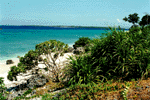"...Fuga is the most beautiful of the Babuyan Islands. The people there live in almost total seclusion from the rest of civilization" (The Lonely Planet Guide To The Philippines).

Several presidents have tried to push through the Comprehensive Agrarian Reform Program. The premise of the program is that natives who have lived and farmed on the same land for generations are entitled to a portion of the land. The first president to push the program was Diosdado Macapagal in 1963. Others including Corazon Aquino have tried. But it's difficult to get the program implemented because the Philippine parliament is dominated by the same people who own the vast tracts of land. Peter Bachmayer, a geographer with the Association for Planning Research in Heidelberg, Germany explains: "Philippine society is divided into a small, rich and politically influential upper class, and a vast number of people who are poor . . . the parliament is dominated by the land-owning oligarchy, who have tried to thwart the reform and allow large landowners to retain their privileges."
|
"...Fuga is the most beautiful of the Babuyan Islands. The people there live in almost total seclusion from the rest of civilization" (The Lonely Planet Guide To The Philippines). |
 |
The population on Fuga is a clan of 2,000 Ilokanos, all united by a common ancestry. They have lived and farmed on Fuga for generations. But they are treated as squatters. A $50 Billion development is transforming Fuga into "A Model City of the 21st Century ... without squatters" (cover story: Asiaweek, Feb/2/96). The island will have 17 golf courses, 12,000 luxurious hotel rooms and the biggest gambling casino on earth.
 Meanwhile, the poor natives are not allowed to marry outsiders and live together on Fuga. Neither are they allowed to build huts. So, up to 16 relatives live in one small hut. If they disobey the rules, they are forced off the island. They have no rights. Not to the land. Not to their huts. Not even to their hard-working water buffalos and ponies. For
Meanwhile, the poor natives are not allowed to marry outsiders and live together on Fuga. Neither are they allowed to build huts. So, up to 16 relatives live in one small hut. If they disobey the rules, they are forced off the island. They have no rights. Not to the land. Not to their huts. Not even to their hard-working water buffalos and ponies. For decades they have toiled as farmers on plots too small to meet their basic needs for nutrition. Malnutrition is common. But they are not allowed to expand their farms. Pregnant women routinely die during pregnancy. Infants are born sick and blind. Half of the infants don't survive. The health crisis (which has dragged on for decades) is complicated by the sad ecological fact: There are no fish left! Although Ferdinand Marcos declared the area a marine preserve, fishermen from the mainland have decimated the reefs of Fuga with dynamite fishing. Consequently, the 400 families cling to existence growing scrubby vegetables. They toil on their farms from dawn to dusk, six days a week. Unemployment is 99 per cent. Half of the population is sick. Infant mortality is a staggering 50 per cent!
decades they have toiled as farmers on plots too small to meet their basic needs for nutrition. Malnutrition is common. But they are not allowed to expand their farms. Pregnant women routinely die during pregnancy. Infants are born sick and blind. Half of the infants don't survive. The health crisis (which has dragged on for decades) is complicated by the sad ecological fact: There are no fish left! Although Ferdinand Marcos declared the area a marine preserve, fishermen from the mainland have decimated the reefs of Fuga with dynamite fishing. Consequently, the 400 families cling to existence growing scrubby vegetables. They toil on their farms from dawn to dusk, six days a week. Unemployment is 99 per cent. Half of the population is sick. Infant mortality is a staggering 50 per cent!
Thank God for the albulareos (traditional healers) on Fuga like the Pablo brothers, Florendo and Henaro. These humble farmers channel the time-honoured Anito Spirit. If it wasn't for the albulareos, infant mortality on Fuga would not be 50 percent. It would be 75 percent! If only the brothers had the power to manifest food from air, they could tackle the island's perpetual killer: malnutrition.